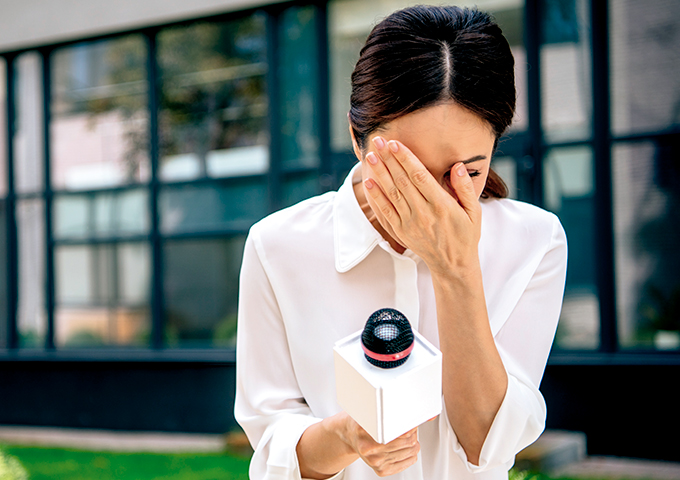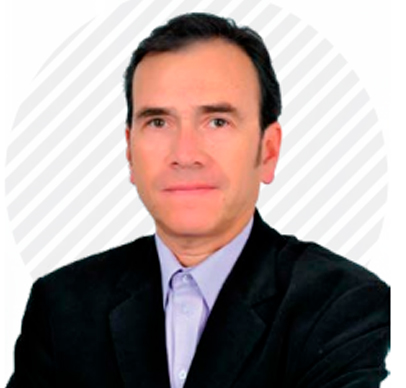The journalists facing the challenge of pain
By: Magda Páez Torres
Photos:
Society and Culture

By: Magda Páez Torres
Photos:
Carlos Gurumendi is an Ecuadorian journalist. As he recounts to his viewers the grim picture due to the countless deaths from COVID-19 in Guayaquil, he collapses. The lump in the throat prevents him from continuing, and in tears, he gives out the news. On his face, the pain of a city is reflected wherein bells do not stop tolling!
Reporters frequently face pain in smaller or greater proportions. However, just as sometimes communicators can break down during some experiences, the scenarios wherein an interviewee succumbs to their own tragedy are even more frequent. Natural disasters, murders, kidnappings, or pandemics often make protagonists from the victims who— many times—appear before the microphones with their grief lying on the surface and are bombarded or revictimized by the stings of questions that should never have been formulated.
The question is, then, that of whether to report pain or not.For Germán Ortiz, professor and researcher at Universidad del Rosario, facing painful situations while exercising journalism is inescapable; the challenge lies in how to approach them without profaning that private space of emotion, which corresponds only to the one who carries those emotions on their shoulders.
In his research study entitled A moral bet to reach quality in the informative treatment of pain, Ortiz emphasizes the fine line that journalists should never cross when it comes to transmitting personal and collective tragedies, but he also insists on the need to report these types of cases for the sake of raising awareness about a specific problem or simply making visible a situation that requires policymaking or more forceful action from the authorities or governments.
or researchers, ethics and morals enter the scene in painful circumstances as the journalists themselves must set limits. ““Prudence is a cardinal virtue that, when one, as a reporter, puts it into practice, works very well. We must evaluate whether it is time to ask that to our interviewee, think of being in their place, whether we would or would not like that questioning; here comes the famous golden rule: Do not do to others what you do not want to be done to you”, he affirms..
Professor Ortiz highlights two types of values in journalism: The procedural ones, related to aspects such as precision, proportionality, context, transparency, and objectivity, and the interpretive ones, linked to the need to understand the context of human actions, particularly in acts of pain. Both, he clarifies, are necessary for a good reporting exercise.
Although the desire for ratings has many times led the media to emphasize crying or other expressions of pain, the investigator emphasizes that journalists should not lose their focus: To elaborate news substantially, without taking the easy way, which involves staying in the emotional moment.
“Sometimes there is no need to arrive in the moment of tragedy. The most important facet is to have the dimension of the fact, not for mere sentimentality, but for the meaning and the nature of the event itself—to transcend from the information of the simple facts. A crying person will always make an impact, but we can do it differently with a more respectful look and without losing the sad nature of the fact and the meaning of pain, which is what, ultimately, we also try to show”,says Ortiz.
Therefore, it highlights how, in the middle of a global emergency, such as the COVID-19 pandemic, the face of a doctor or nurse is marked by the traces of a mask’s extended use; the picture of an empty city that previously ‘never slept’, such as New York; and the union of thousands of people in Italy, singing in unison from the windows, can sensitize the public more and/or better than deaths at close range, with no need to delve into the wounds of the mourners.

“This context has shown us that people need the press, journalism, and journalists because it is through them that we know about the tragedy of the world; it is not through social networks, where a lot of information circulates that is not always true”, assures researcher Germán Ortiz.
Although the red chronicle has taken the headlines in some newsrooms under the asumption that the public prefers this type of information, according to the researcher, media responsibility should prevail. In this sense, it alludes to the agenda-setting theory posited by Maxwell McCombs and Donald Shaw: “The media tells us what to think and also how to think; when they qualify the information and give hierarchy to the facts, people end up speaking of the subject according to the importance that the press has given to it. If we only give people the things that we consider important, it will be easier to determine what people like”, he points out.
In this sense, he affirms that although it is important that citizens know about an assault, we must also prioritize essential information, such as the flow of transport in the region and the prices of the products of the family basket, among other aspects, so that it is not solely negative news that marks the pattern on the agenda.
In today’s digital age, videos —of all sorts and sizes—have taken over the platforms. Traditional and new media have taken a chance on image to capture audiences. Yet amid this heyday, receivers are faced with images of various kinds that can transgress several ethical barriers.
On February 6, 2019, a suicide case shook Colombia. A woman jumped off a bridge in Ibagué with her 10-year-old son. The moment was recorded in a video that, in a matter of seconds, went viral, especially because some media outlets gave in to the temptation of publishing it.
This is a clear example of a heartbreaking case, the images of which should have never come to light by any logic, not even to raise awareness about suicide. The work of ‘morbid curiosity ’ and high ratings was achieved but at a steep price: That of further disrupting a family and community that was already saddened enough by what had happened.
The ‘click dictatorship’to which Professor Ortiz alludes ultimately imposes biased information and at times what is known as‘fake news’.Many digital media even have exclusive sections for the most striking videos, which end up being the ‘most viewed“. ‘What comes faster to people is negative news, falsehoods, or those more scandalous things—that’s why scandals often quickly explode on social networks as they are the most hastily shared“, he emphasizes.
Faced with all these waves of information and alternatives that flood the Internet without any filter, Germán Ortiz argues that media have a historic opportunity to vindicate their role and the need to turn to journalism to obtain accurate information.
The recent COVID-19 pandemic—he says— reinforced the key role of journalism for society, with reporters who, day and night, have faced the risk of infection to carry information to the homes of restless families who are eager to acquire knowledge concerning the progress of the virus and the evolution of measures for its containment.
This is the moral reason for journalism! Ortiz alludes to the same:“This context has shown us that people need the press, journalism, and journalists because it is through them that we know about the tragedy of the world; it is not through social networks, where a lot of information circulates that is not always true ”.
his confirms the legitimacy and credibility that the media have lost, and we are going through a considerably important moment to recover them, adds the investigator. “In the worst health crisis in the past century and perhaps the worst political crisis since World War II, the role of journalism is crucial”, he says.
Given things as they are and facing this challenge, reporters also face an enormous commitment with society to rebuild the news, to transcend scandal to get to the bottom of events, and to question themselves before taking the next step in situations that involve pain, which are inherent in life and to this profession, which requires empathy and undoubtedly self-regulation.
The Polish journalist Ryszard Kapuscinski said it well: “Bad people can’t be good journalists”. Although this phrase has become almost a principle in the industry —as Professor Ortiz points out— it would be truly worth it for each reporter, before putting on their boots, to walk the street and face tragedy, to internalize, and to practice the saying to keep pace with and do justice to their source, their media, and their audience.